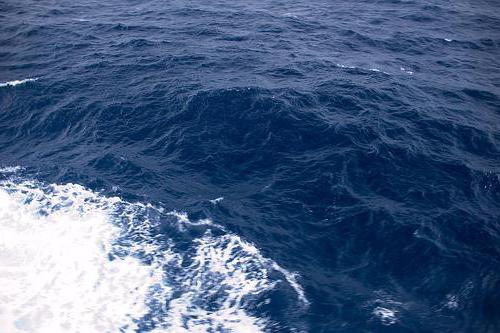The Kuroshio Current was formed as a result of the tangential direction of the wind in the eastern and southern parts of Japan. The air masses near the western borders of the mainland, acting on the upper layers of the ocean surface, are so strong that the resulting water flow develops into a powerful border movement of the Pacific Ocean.
Title
The name "Kuroshio" comes from the merger of two Japanese words: "kuro" - dark and "sio" - current. "Dark waters" actually have a pleasant bluish tint with high transparency of water: the depth is visible at a distance of 40 m.
According to the oceanological characteristic, the Kuroshio Current is a warm circulating stream, the waters of which move from the equator to the North Pole. The maximum surface temperature reaches + 28 ° C. The Kuroshio oscillation level does not leave 90 °, therefore it is classified as constant.
The nature of the water masses
The water masses of the Kuroshio current originate in the northern part of the central waters of the Pacific Ocean. In the East China Sea between the straits of the Ryukyu and Taiwan islands, the waters of the Northern Passat Current are rapidly increasing in volume up to 2 times. This place is considered to be the beginning of this stream. The Kuroshio Current is warm, fed from sources located in the northeast.
By the nature of the circulating water masses, Kuroshio is referred to meandering flows. What does this mean? Simply put, this is a flow with constant wave vortices. The main cycles occur at the borders at the confluence with the Kuril water flows in the north. Mass unrests cause frequent temperature fluctuations on the surface of Kuroshio: winds from the north-west cool the temperature near the waters of Cape Sionomisaki to 8 ° C. The latitude of penetration of northern flows reaches 37–42 °, depending on the season.
Due to the influence of thermohaline forces (processes on the surface of the water associated with an uneven distribution of density and mass of the World Ocean), Kuroshio waters are combined in composition and properties: the lower layer is a subarctic mass with low salinity, the central layer is formed in the Pacific Ocean (salt content does not exceed 36 ppm), surface - the warmest (+ 22 ° C). During the circulation of the oceans, water masses mix with deep currents and subtropical currents.
Flow rate
Kuroshio current has an average speed. At the maximum distance, it does not exceed 6 knots. This value is achieved in the process of merging the warm masses of the stream with the cold current from the Kuril Islands or in southern Japan. Kuroshio’s speed is not evenly distributed: in Okinawa and Taiwan it is low (2 knots), and closer to the northern part of the “dark current” it increases again. The pace also varies depending on the season: warm trade winds accelerate water to maximum speed in the summer, and by the fall it decreases again.
Additional characteristic
The course of Kuroshio is often compared to the Gulf Stream. It carries warm waters that favor a balanced climate in the region. Cold masses on the east coast of Japan mix with the flow of warm masses of Kuroshio, forming climatic conditions suitable for the ecosystem.
It is generally accepted that the depth of the current is measured by 450 meters of water mass, consisting of two layers of the Pacific Ocean differing in density. Although there is an inaccuracy in this division: the lower layer of subarctic waters is much deeper, but due to the difference in composition and low flow rate, its characteristics are not taken into account when determining the area and depth. The course of Kuroshio (warm or cold indicated above) is surprising in its characteristics, which I constantly want to talk about. Particularly impressive landscapes. The maximum width of the stream reaches 79.9 km. This figure is obtained when merging with deep waters and cold currents from the eastern coast of Japan.

The country of the rising sun has always pleased with its beauty, which is constantly noted by tourists. The climatic conditions of this region are very satisfactory, which allows providing comfortable living conditions. Being close to the current, you must be careful, as it is too strong.
After reading this article, it will be easy for any student to answer the question of where the Kuroshio Current is located.